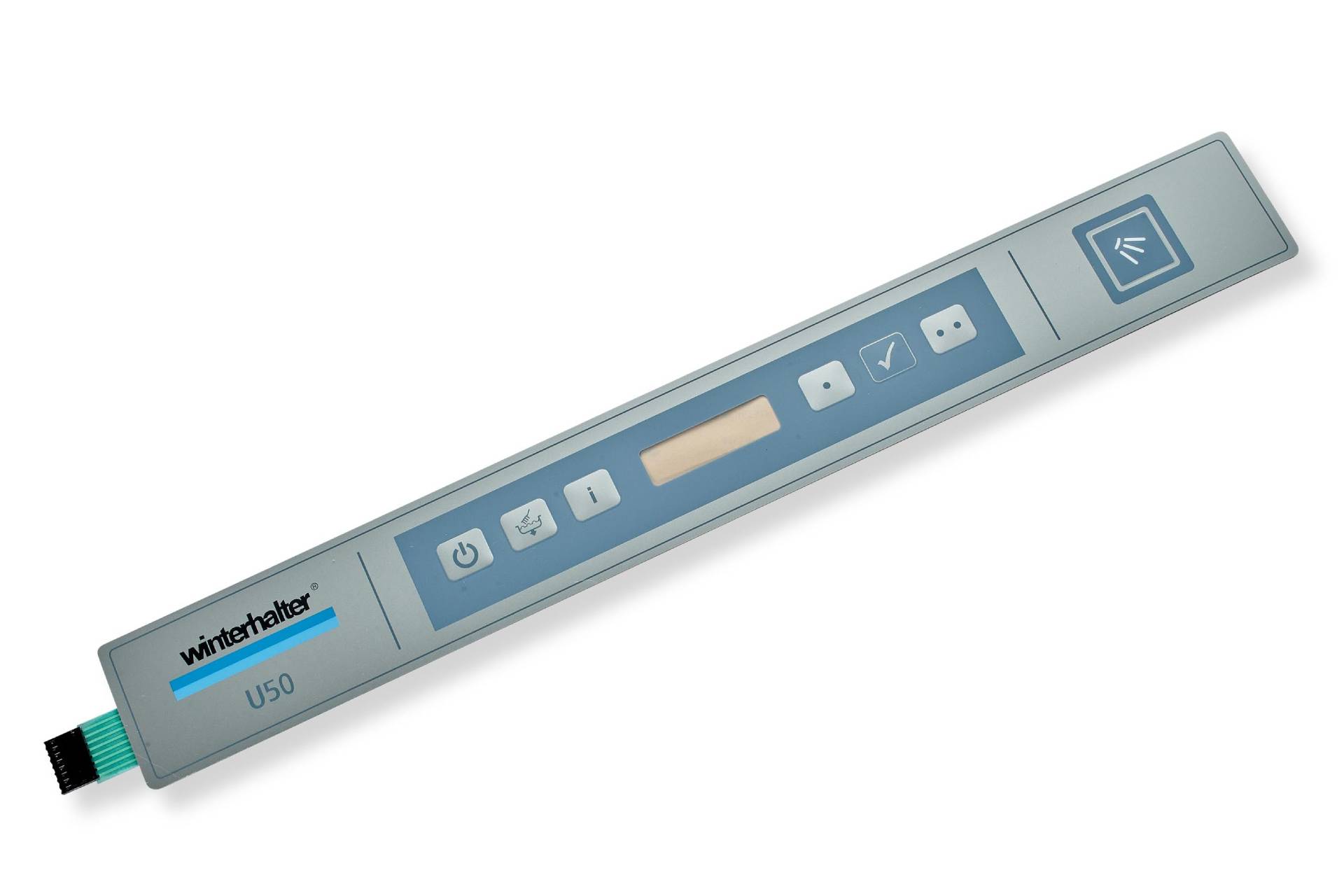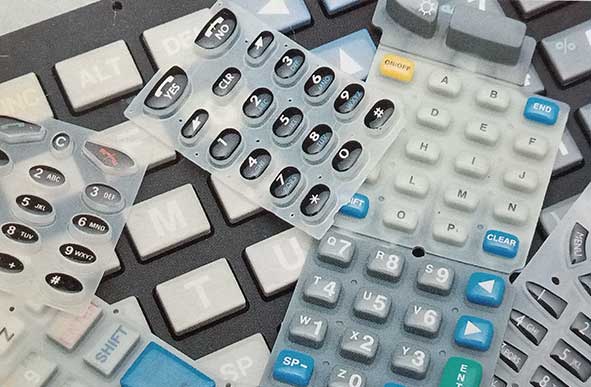How to choose the best Rubber Keypads for factory use
Wiki Article
Discovering the Production Refine Behind Rubber Keypads and Their Relevance in Modern Gadgets
Rubber keypads are essential in the performance of modern-day devices. Their manufacturing procedure involves mindful choice of materials and specific strategies. Keypads are developed to boost individual communication while making sure durability and reliability. Understanding just how these components are made reveals their importance across numerous applications. What variables contribute to their performance, and exactly how do these elements influence customer experience? The answers might improve assumptions of this everyday modern technology.Summary of Rubber Keypads and Their Applications

Rubber keypads are functional parts extensively utilized in different electronic devices, varying from consumer electronics to industrial equipment. Their layout enables a responsive reaction, making them a suitable choice for applications calling for individual interaction. Generally located in products such as push-button controls, calculators, and clinical devices, rubber keypads facilitate convenience of usage and availability.
In industrial setups, they offer important functions in equipment and control panels, where resilience and resistance to environmental aspects are essential. The non-slip surface area enhances grasp, promoting integrity sought after conditions. In addition, their light-weight nature and personalized shapes make it possible for producers to produce tailored options that fit particular needs. With innovations in innovation, rubber keypads continue to advance, including attributes like backlighting and improved level of sensitivity. Generally, their adaptability and useful benefits contribute substantially to the effectiveness of different devices across multiple markets.
Products Made Use Of in Rubber Keypad Production
Keypad making counts on a selection of materials that improve both capability and longevity. The primary material used in the manufacturing of rubber keypads is silicone rubber, understood for its superb durability and flexibility. This product allows keypads to stand up to repeated pushing without shedding form or efficiency. In addition, thermoplastic elastomers (TPE) are commonly made use of as a result of their simplicity of molding and capacity to offer a soft-touch feeling.Coloring agents, such as pigments, are incorporated to ensure lively, durable colors that enhance aesthetic allure. Moreover, additives like anti-UV agents and flame resistants might be blended into the rubber to boost weather resistance and security compliance. The option of materials directly impacts the keypad's tactile reaction, durability, and overall performance in different tools. Ultimately, the cautious choice of these components is vital for the manufacturing of top quality rubber keypads that meet consumer and sector needs.
The Layout Process of Rubber Keypads
When developing rubber keypads, the style process plays an important role in determining capability and individual experience. Designers start by defining the keypad's meant usage, taking into consideration aspects such as the gadget it will come with and the target user demographic. This preliminary stage includes laying out layouts that focus on ergonomic elements, ensuring the keys are quickly available and properly spaced.Next off, designers concentrate on the tactile feedback preferred from the keypads, which influences the selection of products and essential forms. Prototyping is essential in this phase, enabling designers to check various layouts for convenience and responsiveness.

Manufacturing Techniques for Rubber Keypads
The manufacturing process for rubber keypads includes a collection of precise techniques that assure high quality and capability. Liquid silicone rubber (LSR) is typically utilized due to its longevity and versatility. The process starts with blending the raw materials, consisting of silicone, colorants, and healing agents. This mix is then infused right into molds designed to shape the keypads accurately.
Following injection, the molded keypads go through healing, a heating process that strengthens the product (Rubber Keypads). This is commonly performed in a press, making sure the keypads accomplish the wanted hardness and durability

Quality Assurance Procedures in Production
To guarantee that rubber keypads satisfy high criteria of high quality and functionality, rigorous high quality control actions are carried out throughout the production procedure. These steps begin with resources assessment, making certain that just the highest-grade elastomers are used. During the manufacturing stage, operators carry out routine checks to keep an my latest blog post eye on parameters such as temperature, pressure, and blending times, essential for attaining constant item quality.Post-production, each batch of keypads goes through thorough screening, consisting of responsive feedback assessments and resilience examinations to review performance under various problems. Aesthetic evaluations are also carried out to identify any defects, such as bubbles or inconsistencies in appearance. Furthermore, conformity with sector requirements is confirmed, making sure that the keypads satisfy safety and security and performance criteria.
The Duty of Modern Technology in Keypad Development
Modern technology plays an important role in the growth of rubber keypads by enabling innovative manufacturing techniques that enhance precision and efficiency. Furthermore, innovative product choice permits enhanced sturdiness and responsiveness in keypad performance. These improvements not only streamline production yet additionally raise the total high quality of the last item.Advanced Production Techniques
Innovations in production techniques change the production of rubber keypads, improving both performance and precision. Technologies such as shot molding and 3D printing have actually transformed typical processes, enabling manufacturers to create complex layouts with reduced waste and enhanced turnaround times. Automation plays a vital duty in this evolution, improving assembly lines and decreasing human error. In addition, computer-aided layout (CAD) software program enables for intricate customization, making sure that keypads fulfill certain user demands. Quality control steps have actually likewise progressed, integrating real-time surveillance systems that spot flaws early in the manufacturing cycle. These developments not just boost the resilience and capability of rubber keypads but also sustain the growing need for tailored services in different markets, from consumer electronics to auto applications.Innovative Material Choice
The development of manufacturing methods has actually led the way for cutting-edge product option in rubber keypad growth. Developments in polymer science have introduced materials that enhance sturdiness, flexibility, and responsive comments. Manufacturers now utilize polycarbonate elastomers (TPE) and silicone substances, which give superior resistance to wear and ecological factors. These products permit the development of keypads that can withstand extended use while maintaining aesthetic charm. Furthermore, the combination of additives and coverings enhances functionality, such as enhancing grip and reducing friction. The selection of materials is essential, as it straight impacts the efficiency and longevity of keypads in various devices, from customer electronic devices to commercial tools. This cutting-edge method remains to shape the future of keypad design and use.The Influence of Rubber Keypads on Individual Experience
Rubber keypads significantly influence customer experience with their enhanced responsive reaction, which enables more accurate communication. Additionally, their sturdiness and durability add to regular performance over time, minimizing the need for frequent substitutes. This combination of features makes rubber keypads a preferred choice in different applications, inevitably influencing individual fulfillment.Enhanced Tactile Response
Enhancing responsive reaction considerably influences individual experience, specifically in tools that depend on keypads for interaction. Rubber keypads offer a distinct combination of soft qualities and resilience, permitting users to really feel distinctive comments with each press. This feedback enhances a sense of control and precision, important in applications varying from mobile phones to commercial equipment. Users commonly report higher contentment and performance when engaging with read what he said gadgets that feature well-designed rubber keypads, as they facilitate quicker and much more accurate input. Additionally, the ergonomic design of these keypads can lower finger exhaustion, promoting longer usage durations without discomfort. Generally, the improved responsive action offered by rubber moved here keypads substantially adds to a much more intuitive and satisfying individual experience in modern technology.Sturdiness and Longevity
An essential facet of user experience with rubber keypads depends on their toughness and long life. These keypads are made to withstand extensive usage, standing up to damage that frequently influences other materials. The durable nature of rubber guarantees that keypads maintain their performance and look with time, which is important for gadgets frequently used in various settings. Individuals take advantage of the dependability of rubber keypads, as they can endure direct exposure to dust, temperature level, and moisture changes without deteriorating. This durability not just improves user satisfaction but also minimizes the demand for frequent replacements, inevitably adding to cost-effectiveness for suppliers. Essentially, the longevity of rubber keypads considerably affects the total efficiency and individual experience in modern tools.Often Asked Questions
How Much Time Do Rubber Keypads Generally Last in Devices?
Rubber keypads normally last in between 5 to 10 years, depending on usage, ecological elements, and top quality of products utilized (Rubber Keypads). Routine damage can reduce their life expectancy, affecting performance and individual experience over timeCan Rubber Keypads Be Custom-made for Details Applications?
Rubber keypads can without a doubt be customized for certain applications, permitting changes in size, shade, form, and texture. This versatility enables suppliers to create customized services that fulfill varied individual demands and improve capability in different tools.Are Rubber Keypads Eco-friendly?
Rubber keypads are commonly ruled out eco-friendly as a result of their petroleum-based materials. Improvements in sustainable production practices and the advancement of bio-based alternatives are gradually boosting their eco-friendly influence in various applications.What Are Common Concerns Faced During Rubber Keypad Production?
Common concerns dealt with during rubber keypad manufacturing consist of irregular worldly top quality, mold and mildew flaws, improper curing times, bond failures, and challenges in attaining exact responsive comments. These issues can lead to decreased item performance and client discontentment.How Do Rubber Keypads Compare to Other Kinds Of Secret Changes?
Rubber keypads supply a softer feel and quieter operation compared to mechanical buttons, which provide responsive comments. Nevertheless, rubber keypads might wear faster and do not have the precision that some customers like in high-performance applications.The main product made use of in the production of rubber keypads is silicone rubber, recognized for its excellent durability and versatility. When creating rubber keypads, the layout process plays a crucial role in establishing functionality and individual experience. Rubber keypads greatly affect customer experience through their enhanced tactile reaction, which enables for even more accurate interaction. Customers commonly report greater satisfaction and effectiveness when connecting with tools that feature properly designed rubber keypads, as they help with quicker and more precise input. A vital aspect of user experience with rubber keypads exists in their longevity and durability.
Report this wiki page